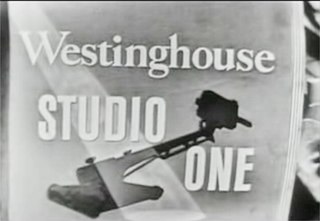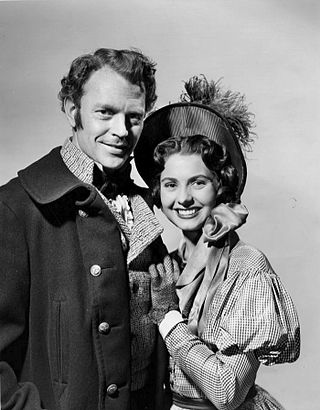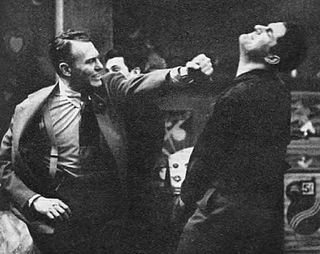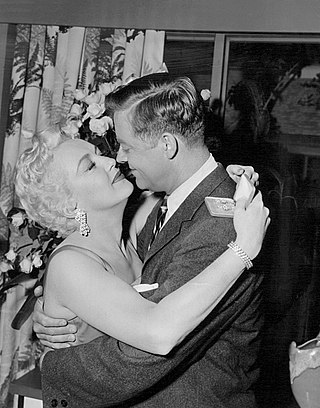The year 1953 in television involved some significant events. Below is a list of television-related events during 1953.

Lux Video Theatre is an American television anthology series that was produced from 1950 until 1957. The series presented both comedy and drama in original teleplays, as well as abridged adaptations of films and plays.

An anthology series is a written series, radio, television, film, or video game series that presents a different story and a different set of characters in each different episode, season, segment, or short. These usually have a different cast in each episode, but several series in the past, such as Four Star Playhouse, employed a permanent troupe of character actors who would appear in a different drama each week. Some anthology series, such as Studio One, began on radio and then expanded to television.

Studio One is an American anthology drama television series that was adapted from a radio series. It was created in 1947 by Canadian director Fletcher Markle, who came to CBS from the CBC. It premiered on November 7, 1948, and ended on September 29, 1958, with a total of 467 episodes over the course of 10 seasons.
The Philco Television Playhouse is an American television anthology series that was broadcast live on NBC from 1948 to 1955. Produced by Fred Coe, the series was sponsored by Philco. It was one of the most respected dramatic shows of the Golden Age of Television, winning a 1954 Peabody Award and receiving eight Emmy nominations between 1951 and 1956.
The following is the 1957–58 network television schedule for the four major English language commercial broadcast networks in the United States. The schedule covers primetime hours from September 1957 through March 1958. The schedule is followed by a list per network of returning series, new series, and series cancelled after the 1956–57 season.

Four Star Playhouse is an American anthology series that ran from September 25, 1952, through September 27, 1956.
The 1955–56 network television schedule for the four major English language commercial broadcast networks in the United States. The schedule covers primetime hours from September 1955 through March 1956. The schedule is followed by a list per network of returning series, new series, and series cancelled after the 1954–55 season.

Schlitz Playhouse of Stars is an anthology series that was telecast from 1951 until 1959 on CBS. Offering both comedies and drama, the series was sponsored by the Joseph Schlitz Brewing Company. The title was shortened to Schlitz Playhouse beginning with the fall 1957 season.

Ford Theatre, spelled Ford Theater for the original radio version and known, in full, as The Ford Television Theatre for the TV version, is a radio and television anthology series broadcast in the United States in the 1940s and 1950s. At various times the television series appeared on all three major television networks, while the radio version was broadcast on two separate networks and on two separate coasts. Ford Theatre was named for its sponsor, the Ford Motor Company, which had an earlier success with its concert music series, The Ford Sunday Evening Hour (1934–42).
The Best of Broadway is a 60-minute live television anthology series that aired on CBS Television on Wednesdays at 10 p.m. Eastern Standard Time from September 15, 1954, to May 4, 1955, for a total of nine episodes. Each show was broadcast live in color from New York City, was an adaptation of a famous Broadway play, and included commercials for Westinghouse featuring Betty Furness. Using a "giant new studio," plays were presented in front of a studio audience, which contributed a Broadway-like element.

Man Against Crime starring Ralph Bellamy, one of the first television programs about private eyes, ran on CBS, the DuMont Television Network and NBC from October 7, 1949, to June 27, 1954, and was briefly revived, starring Frank Lovejoy, during 1956. The show was created by Lawrence Klee and was broadcast live until 1952. The series was one of the few television programs ever to have been simulcast on more than one network: the program aired on both NBC and DuMont during the 1953–54 television season.
Front Row Center is the title of two American television programs with different formats that were broadcast on different networks.
Hands of Murder is an American mystery anthology series that aired on the DuMont Television Network from August 24, 1949, through December 11, 1951.
Gruen Playhouse is an American dramatic anthology series that was known as Gruen Guild Playhouse when it debuted on ABC on September 27, 1951. "Guild" was dropped from the title when it was shown on the DuMont Television Network from January 17, 1952, until July 3, 1952.
Rebound is an anthology television series which aired on both the ABC and on the DuMont networks. Featuring dramatic stories with unusual endings, the series ran from February 8, 1952, to May 30, 1952, on ABC and from November 21, 1952, to January 16, 1953, on DuMont. The ABC series aired Fridays from 9 to 9:30pm ET.
Your Play Time is a 30-minute American television anthology series that ran as a summer replacement show in 1953, 1954, and 1955.
The Whistler is a 30-minute syndicated American television anthology mystery series, based on the radio series of the same name.

Star Stage is a half-hour American television anthology series that began on September 9, 1955, and ended on September 7, 1956.







